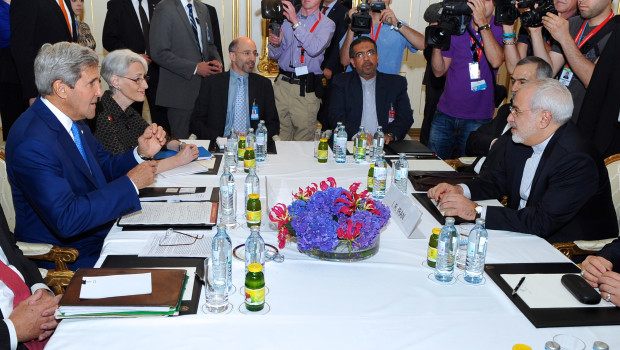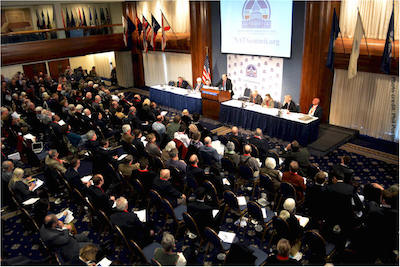“Text of April 2 Agreement with Iran” (indicates Iran doesn’t desire nuclear weapons)
Apr 4 2015 / 5:48 pm
The Iran agreement appears to be wildly unbalanced, with Iran agreeing to extremely stringent restrictions on its nuclear rights in return for relatively vague assurances regarding the relaxation and eventual lifting of the sanctions imposed upon it.
It is difficult to believe that Iran would have agreed to such terms unless both (1) the unanimous assessment of all 17 American intelligence agencies that Iran does not have any nuclear weapons program and (2) Iran’s persistent insistence that it does not wish to possess nuclear weapons (supported by the Supreme Leader’s fatwa declaring nuclear weapons un-Islamic) were true.
John Whitbeck – Below is the U.S. State Department’s summary of the “key parameters” of the framework agreement reached yesterday between Iran and the P5+1.
If this summary is reasonably accurate (and not misleading spin directed at a Congressional audience), the framework agreement appears to be wildly unbalanced, with Iran agreeing to extremely stringent and precise restrictions on its nuclear rights in return for relatively vague, conditional and imprecise assurances regarding the relaxation and eventual lifting of the sanctions imposed upon it.
It is difficult to believe that Iran would have agreed to such terms unless both (i) the unanimous assessment of all 17 American intelligence agencies that Iran does not have any nuclear weapons program and (ii) Iran’s persistent insistence that it does not wish to possess nuclear weapons (supported by the Supreme Leader’s fatwa declaring nuclear weapons un-Islamic) were true.
Nevertheless, Israel’s leading stand-up comedian, Mark Regev, promptly told journalists that “This framework is a step in a very, very dangerous direction”, adding that Iran’s “single goal” behind the accord was to build a nuclear bomb.
Presumably, orders will be issued to Israel’s faithful and obedient servants in the U.S. Congress to sabotage the agreement and, thereby, to keep the world’s attention focused on the non-existent Iranian “threat” rather than on the very real occupation of Palestine.
One may hope that the unbalanced nature of this agreement will make it more difficult to assemble veto-proof two-thirds majorities in both the House and Senate in favor of putting the Israeli government’s desires ahead of America’s and the world’s interests, but, since reality is of little concern on Capitol Hill, a sane Congressional reaction cannot be assured.
An excellent account of the process leading to yesterday’s agreement is in the GUARDIAN.
Text of April 2 Agreement with Iran
The following document, released on April 2 by the State Department press office, itemizes the points of agreement between Iran, the P5+1 (the UN Security Council members plus Germany), and the European Union. Its official title is: Parameters for a Joint Comprehensive Plan of Action regarding the Islamic Republic of Iran’s Nuclear Program.
Below are the key parameters of a Joint Comprehensive Plan of Action (JCPOA) regarding the Islamic Republic of Iran’s nuclear program that were decided in Lausanne, Switzerland. These elements form the foundation upon which the final text of the JCPOA will be written between now and June 30, and reflect the significant progress that has been made in discussions between the P5+1, the European Union, and Iran. Important implementation details are still subject to negotiation, and nothing is agreed until everything is agreed. We will work to conclude the JCPOA based on these parameters over the coming months.
Enrichment
• Iran has agreed to reduce by approximately two-thirds its installed centrifuges. Iran will go from having about 19,000 installed today to 6,104 installed under the deal, with only 5,060 of these enriching uranium for 10 years. All 6,104 centrifuges will be IR-1s, Iran’s first-generation centrifuge.
• Iran has agreed to not enrich uranium over 3.67 percent for at least 15 years.
• Iran has agreed to reduce its current stockpile of about 10,000 kg of low-enriched uranium (LEU) to 300 kg of 3.67 percent LEU for 15 years.
• All excess centrifuges and enrichment infrastructure will be placed in IAEA monitored storage and will be used only as replacements for operating centrifuges and equipment.
Iran has agreed to not build any new facilities for the purpose of enriching uranium for 15 years.
• Iran’s breakout timeline – the time that it would take for Iran to acquire enough fissile material for one weapon – is currently assessed to be 2 to 3 months. That timeline will be extended to at least one year, for a duration of at least ten years, under this framework. Iran will convert its facility at Fordow so that it is no longer used to enrich uranium
• Iran has agreed to not enrich uranium at its Fordow facility for at least 15 years.
• Iran has agreed to convert its Fordow facility so that it is used for peaceful purposes only – into a nuclear, physics, technology, research center.
• Iran has agreed to not conduct research and development associated with uranium enrichment at Fordow for 15 years.
• Iran will not have any fissile material at Fordow for 15 years.
• Almost two-thirds of Fordow’s centrifuges and infrastructure will be removed. The remaining centrifuges will not enrich uranium. All centrifuges and related infrastructure will be placed under IAEA monitoring. Iran will only enrich uranium at the Natanz facility, with only 5,060 IR-1 first-generation centrifuges for ten years.
Iran has agreed to only enrich uranium using its first generation (IR-1 models) centrifuges at Natanz for ten years, removing its more advanced centrifuges.
• Iran will remove the 1,000 IR-2M centrifuges currently installed at Natanz and place them in IAEA monitored storage for ten years. • Iran will not use its IR-2, IR-4, IR-5, IR-6, or IR-8 models to produce enriched uranium for at least ten years. Iran will engage in limited research and development with its advanced centrifuges, according to a schedule and parameters which have been agreed to by the P5+1.
• For ten years, enrichment and enrichment research and development will be limited to ensure a breakout timeline of at least 1 year. Beyond 10 years, Iran will abide by its enrichment and enrichment R&D plan submitted to the IAEA, and pursuant to the JCPOA, under the Additional Protocol resulting in certain limitations on enrichment capacity.
Inspections and Transparency
• The IAEA will have regular access to all of Iran’s nuclear facilities, including to Iran’s enrichment facility at Natanz and its former enrichment facility at Fordow, and including the use of the most up-to-date, modern monitoring technologies.
• Inspectors will have access to the supply chain that supports Iran’s nuclear program. The new transparency and inspections mechanisms will closely monitor materials and/or components to prevent diversion to a secret program.
• Inspectors will have access to uranium mines and continuous surveillance at uranium mills, where Iran produces yellowcake, for 25 years.
• Inspectors will have continuous surveillance of Iran’s centrifuge rotors and bellows production and storage facilities for 20 years. Iran’s centrifuge manufacturing base will be frozen and under continuous surveillance.
• All centrifuges and enrichment infrastructure removed from Fordow and Natanz will be placed under continuous monitoring by the IAEA.
• A dedicated procurement channel for Iran’s nuclear program will be established to monitor and approve, on a case by case basis, the supply, sale, or transfer to Iran of certain nuclear-related and dual use materials and technology – an additional transparency measure.
• Iran has agreed to implement the Additional Protocol of the IAEA, providing the IAEA much greater access and information regarding Iran’s nuclear program, including both declared and undeclared facilities.
• Iran will be required to grant access to the IAEA to investigate suspicious sites or allegations of a covert enrichment facility, conversion facility, centrifuge production facility, or yellowcake production facility anywhere in the country.
• Iran has agreed to implement Modified Code 3.1 requiring early notification of construction of new facilities.
• Iran will implement an agreed set of measures to address the IAEA’s concerns regarding the Possible Military Dimensions (PMD) of its program.
Reactors and Reprocessing
• Iran has agreed to redesign and rebuild a heavy water research reactor in Arak, based on a design that is agreed to by the P5+1, which will not produce weapons grade plutonium, and which will support peaceful nuclear research and radioisotope production.
• The original core of the reactor, which would have enabled the production of significant quantities of weapons-grade plutonium, will be destroyed or removed from the country.
• Iran will ship all of its spent fuel from the reactor out of the country for the reactor’s lifetime.
• Iran has committed indefinitely to not conduct reprocessing or reprocessing research and development on spent nuclear fuel.
• Iran will not accumulate heavy water in excess of the needs of the modified Arak reactor, and will sell any remaining heavy water on the international market for 15 years.
• Iran will not build any additional heavy water reactors for 15 years.
Sanctions
• Iran will receive sanctions relief, if it verifiably abides by its commitments.
• U.S. and E.U. nuclear-related sanctions will be suspended after the IAEA has verified that Iran has taken all of its key nuclear-related steps. If at any time Iran fails to fulfill its commitments, these sanctions will snap back into place.
• The architecture of U.S. nuclear-related sanctions on Iran will be retained for much of the duration of the deal and allow for snap-back of sanctions in the event of significant non-performance.
• All past UN Security Council resolutions on the Iran nuclear issue will be lifted simultaneous with the completion, by Iran, of nuclear-related actions addressing all key concerns (enrichment, Fordow, Arak, PMD, and transparency).
• However, core provisions in the UN Security Council resolutions – those that deal with transfers of sensitive technologies and activities – will be re-established by a new UN Security Council resolution that will endorse the JCPOA and urge its full implementation. It will also create the procurement channel mentioned above, which will serve as a key transparency measure. Important restrictions on conventional arms and ballistic missiles, as well as provisions that allow for related cargo inspections and asset freezes, will also be incorporated by this new resolution.
• A dispute resolution process will be specified, which enables any JCPOA participant, to seek to resolve disagreements about the performance of JCPOA commitments. • If an issue of significant non-performance cannot be resolved through that process, then all previous UN sanctions could be re-imposed.
• U.S. sanctions on Iran for terrorism, human rights abuses, and ballistic missiles will remain in place under the deal.
Phasing
• For ten years, Iran will limit domestic enrichment capacity and research and development – ensuring a breakout timeline of at least one year. Beyond that, Iran will be bound by its longer-term enrichment and enrichment research and development plan it shared with the P5+1.
• For fifteen years, Iran will limit additional elements of its program. For instance, Iran will not build new enrichment facilities or heavy water reactors and will limit its stockpile of enriched uranium and accept enhanced transparency procedures.
• Important inspections and transparency measures will continue well beyond 15 years. Iran’s adherence to the Additional Protocol of the IAEA is permanent, including its significant access and transparency obligations. The robust inspections of Iran’s uranium supply chain will last for 25 years.
• Even after the period of the most stringent limitations on Iran’s nuclear program, Iran will remain a party to the Nuclear Non-Proliferation Treaty (NPT), which prohibits Iran’s development or acquisition of nuclear weapons and requires IAEA safeguards on its nuclear program.
http://www.lobelog.com/text-

